Infrared Thermography Goes Underground
 Moving more than 5 million people over almost 850 miles of track each day is a challenging proposition for one of America’s largest subway systems. Reliability and safety are top priorities for this system, which operates 24/7/365.
Moving more than 5 million people over almost 850 miles of track each day is a challenging proposition for one of America’s largest subway systems. Reliability and safety are top priorities for this system, which operates 24/7/365.
Following an electrical incident that resulted in equipment failure and a fire, the subway system’s engineers sought a means to rapidly inspect all of their electrical equipment—most of which was located in cramped, underground tunnels and restricted areas. After weighing several options, they determined that infrared thermography and Jersey Infrared Consultants (jerseyir.com) of Burlington, NJ, best met the subway’s needs:
- Thermal imaging could be performed without shutdowns.
- Collected data could be documented to allow further investigation and repairs of problems, and serve as a baseline for future infrared inspections.
- Electrical equipment could be inspected without walking or standing in the tunnels or on the tracks.
The Plan
This infrared survey project involved inspecting all electrical equipment, including cables, connections, and splices located in manholes or exposed locations within the tunnel and track areas. Its goal was to identify potential problems that could lead to a future failure or fire. Successfully conducting the required inspections, though, meant overcoming numerous logistical hurdles inherent to the transit and tunnel environment.
The first hurdle was when to perform the inspection. To obtain meaningful data, infrared inspections should be performed at a time when there is significant load on electrical systems. In the subway’s case, this would ideally be rush hour. Shutting down tracks or delaying trains during that time, however, was not an option. After some experimentation, it was agreed that infrared inspection of equipment located on the tracks would commence at the end of rush hour and stop after three hours or when the electrical system load was no longer sufficient, whichever came first.
Much of the equipment to be inspected was located in “manholes” or along walls of active subway tunnels. Walking between locations was prohibited due to the many miles of track to be inspected. Standing on or near the tracks with running trains was too dangerous. To safely access the equipment, the client and consultants decided the survey would be performed from the front platform of a work train. Necessary safety equipment included harnesses to secure the thermographers to the work platform and radios to allow communication between them, the train engineer, and transit maintenance engineers.
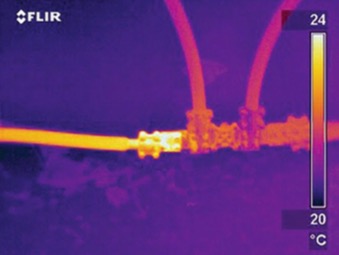

This thermogram shows an increased temperature (white area) at a cable termination.
The Work
Although the survey was performed during “non-peak times,” the subway’s tracks were still in use—and under track- master control. This meant the work train could only move at a speed set by the track master and only stop at specific sites for 45 seconds to two minutes.
During a normal infrared survey, a thermographer begins at point A and continues to points B, C, D, and beyond in a logical, time-efficient manner. As the subway’s survey began, however, it quickly became apparent that proceeding from one point to the next wouldn’t always be possible when working on active tracks. If, for example, the track master directed the work train to “clear the track,” it would immediately have to move to the next sidetrack or onto another track. These interruptions made keeping accurate records of what was inspected and where the survey left off on each track more difficult than usual. Thus, to cover as much ground as possible in the short timeframes that were available, infrared scanning was frequently performed on multiple tracks during the same work shift. Maintaining accurate records was the job of a second thermographer.
A typical shift began 60 minutes before the anticipated start of the scanning window. After agreeing on the work plan for the shift, the thermographers and transit engineers would meet the work train at the designated tunnel platform.
As the work train approached a target area, the train engineer would reduce its speed to a crawl. The thermographer working with the imager on the front platform would begin scanning. Data collected at each location included the highest and lowest cable temperatures and a thermogram and control photograph of detected anomalies.
In a conventional setting, a thermographer has unlimited time to obtain temperatures and adjust the thermal imager controls to record the best infrared image possible. That wasn’t possible on this project, given the fact the work train could not stop in a subject area. Instead, it would have to crawl through it. Moreover, on many occasions, it was ordered to speed up or clear the track before all data could be collected. In these situations, the location was noted so that the train could return to the same spot as soon as possible to complete data collection. Again, accurate documentation by the thermography crew was the key to ensuring complete coverage.
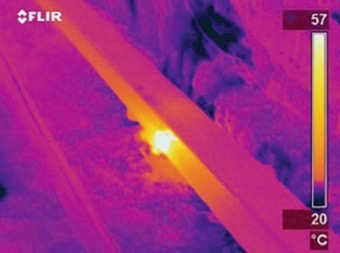
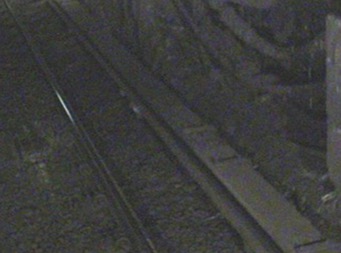
This thermogram shows a typical third-rail problem. At the time this image was taken, there was a 41 C temperature differential between rail sections.
Scope and Findings
The subway’s survey included equipment located in 30 tunnels. At the start of the project, blueprints indicated 327 manholes and/or electrical cabinets to be inspected. As it progressed, unlabeled or “added” manholes were found.
Additional time was called for whenever the thermographers encountered new locations. In these situations, thermographers and transit engineers would have to create a name for the new site that would fit into the system’s nomenclature and allow the area to be quickly located by anyone assigned to repair problems or conduct future infrared inspections. These newly discovered areas were then added to system blueprints for future reference.
During the infrared survey, 394 specific sites—each encompassing multiple cables, splices, connections, and terminations—were inspected. The system’s electrified third rail was also monitored. Overall, a total of 41 thermal anomalies or problems were located and documented. Identified problems included loose connections at cable terminations, unbalanced loads (including some with very high temperature differentials), and damaged splices, as well as hot spots on the third rail.
Note that the cable in a mass transit system is measured in millions of feet. Possible problems in this type of cable system include frayed strands, failed splices, overloads, or poor terminations.
Since it isn’t practical for subway personnel to inspect all of the system’s cables by hand, one goal of the infrared project was to identify cables that did call for further investigation. The thermographers surveyed miles of cable located on and near the tracks. In the process, they detected thermal anomalies indicative of each of the previously referenced problems. Because the system’s transit engineers were working alongside the thermographers, they were able to quickly generate work orders for immediate investigation of the most serious issues.
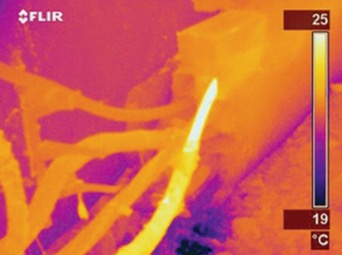
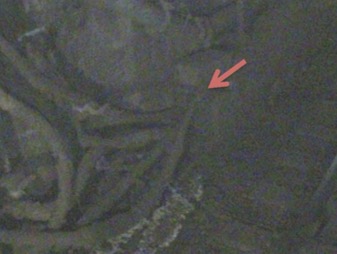
This thermogram shows a cable entering a junction box. Since it was not possible to do further investigation at the time of the survey, actual temperatures within the box might be higher than shown on the cable.
Results
Proper planning and work performed by experienced thermographers allowed the subway to meet its electrical- system inspection goals. All work was performed without system disruption.
The final report included detailed descriptions needed for follow-up and provided a basis for future studies. To assist with a baseline and help with future studies, high and low cable temperatures were recorded at each manhole. Most important, the infrared survey identified many problems that, left unaddressed, could have resulted in equipment failure or safety issues.
The entire project was completed and the final report delivered in less than four weeks, enabling the subway system’s engineers to schedule repairs and corrective actions. MT
Jersey Infrared Consultants (Burlington, NJ) has been providing infrared inspection services for commercial and industrial facilities around the world since 1984. For more information, visit jerseyir.com.
© 2017 Maintenance Technology. All Rights Reserved.
Original article can be viewed at maintenancetechnology.com